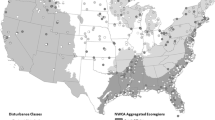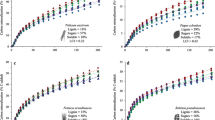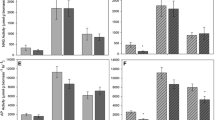Abstract
We compared carbon (C), nitrogen (N), and phosphorus (P) concentrations in atmospheric deposition, runoff, and soils with microbial respiration [dehydrogenase (DHA)] and ecoenzyme activity (EEA) in an ombrotrophic bog and a minerotrophic fen to investigate the environmental drivers of biogeochemical cycling in peatlands at the Marcell Experimental Forest in northern Minnesota, USA. Ecoenzymatic stoichiometry was used to construct models for C use efficiency (CUE) and decomposition (M), and these were used to model respiration (Rm). Our goals were to determine the relative C, N, and P limitations on microbial processes and organic matter decomposition, and to identify environmental constraints on ecoenzymatic processes. Mean annual water, C, and P yields were greater in the fen, while N yields were similar in both the bog and fen. Soil chemistry differed between the bog and fen, and both watersheds exhibited significant differences among soil horizons. DHA and EEA differed by watersheds and soil horizons, CUE, M, and Rm differed only by soil horizons. C, N, or P limitations indicated by EEA stoichiometry were confirmed with orthogonal regressions of ecoenzyme pairs and enzyme vector analyses, and indicated greater N and P limitation in the bog than in the fen, with an overall tendency toward P-limitation in both the bog and fen. Ecoenzymatic stoichiometry, microbial respiration, and organic matter decomposition were responsive to resource availability and the environmental drivers of microbial metabolism, including those related to global climate changes.



Similar content being viewed by others
References
Alexander RB, Bohlke JK, Boyer EW, David MB, Harvey JW, Mulholland PJ, Seitzinger SP, Tobias CR, Tonitto C, Wollheim WM (2009) Dynamic modeling of nitrogen losses in river networks unravels the coupled effects of hydrological and biogeochemical processes. Biogeochemistry 93:91–116
Allen AP, Gillooly JF (2009) Towards an integration of ecological stoichiometry and the metabolic theory of ecology to better understand nutrient cycling. Ecol Lett 12:369–384
American Public Health Association, APHA (1998) In: Clesceri LS, Greenberg AE, Eaton AD (eds) Standard methods for the examination of water and wastewater, 20th edn. American Public Health Association, Washington, DC
Arshad MA, Lowery B, Grossman B (1996) Physical tests for monitoring soil quality. In: Doran JW, Jones AJ (eds) Methods for assessing soil quality. Soil Science Society of America, Madison, pp 123–141
Bragazza L, Freeman C, Jones T, Rydin H, Limpens J, Fenner N, Ellis T, Gerdol R, Hajek M, Hajek T, Iacumin P, Kutnar L, Tahvanainen T, Toberman H (2006) Atmospheric nitrogen deposition promotes carbon loss from peat bogs. Proc Natl Acad Sci USA 103:19386–19389
Bragazza L, Buttler A, Habermacher J, Brancaleoni L, Gerdol R, Fritze H, Hanajik P, Laiho R, Johnson D (2012) High nitrogen deposition alters the decomposition of bog plant litter and reduces carbon accumulation. Glob Change Biol 18:1163–1172
Bridgham SD, Pastor J, Janssens JA, Chapin C, Malterer TJ (1996) Multiple limiting gradients in peatlands: a call for a new paradigm. Wetlands 16:45–65
Bridgham SD, Updegraff K, Pastor J (1998) Carbon, nitrogen, and phosphorus mineralization in northern wetlands. Ecology 79:1545–1561
Bridgham SD, Megonigal JP, Keller JK, Bliss NB, Trettin C (2006) The carbon balance of North American wetlands. Wetlands 26:889–916
Bridgham SD, Pastor J, Dewey B, Weltzin JF, Updegraff K (2008) Rapid carbon response of peatlands to climate change. Ecology 89:3041–3048
Broberg A (1985) A modified method for studies of electron transport system activity in freshwater sediments. Hydrobiologia 120:181–187
Cleveland CC, Liptzin D (2007) C/N/P stoichiometry in soil: is there a “Redfield ratio” for the microbial biomass? Biogeochemistry 85:235–252
Dorrepaal E, Toet S, van Lotestijn RSP, Swart E, van de Weg MJ, Callaghan TV, Aerts R (2009) Carbon respiration from subsurface peat accelerated by climate warming in the subarctic. Nature 460:616–619
Farrish KW, Grigal DF (1988) Decomposition in an ombrotrophic bog and a minerotrophic fen in Minnesota. Soil Sci 145:353–358
Fenner N, Williams R, Toberman H, Hughes S, Reynolds B, Freeman C (2011) Decomposition ‘hotspots’ in a rewetted peatland: implications for water quality and carbon cycling. Hydrobiologia 674:51–66
Foreman CM, Franchini P, Sinsabaugh RL (1998) The trophic dynamics of riverine bacterioplankton: relationships among substrate availability, ectoenzyme kinetics and growth. Limnol Oceanogr 43:1344–1352
Freeman C, Liska NJ, Lock MA, Reynolds B, Hudson J (1996) Microbial activity and enzymic decomposition processes following peatland water table drawdown. Plant Soil 180:121–127
Freeman C, Ostle N, Fenner N, Kang H (2004) A regulatory role for phenol oxidase during decomposition in peatlands. Soil Biol Biochem 36:1663–1667
Frost PC, Benstead JP, Cross WF, Hillebrand H, Larson JH, Xenopoulos MA, Yoshida T (2006) Threshold elemental ratios of carbon and phosphorus in aquatic consumers. Ecol Lett 9:774–779
German DP, Weintraub MN, Grandy AS, Lauber CL, Rinkes ZL, Allison SD (2011) Optimization of hydrolytic and oxidative enzyme methods for ecosystem studies. Soil Biol Biochem 43:1387–1397
Gorham E (1991) Northern peatlands: role in the carbon cycle and probable responses to climatic warming. Ecol Appl 1:182–195
Gorham E, Eisenreich SJ, Ford J, Santelmann MV (1985) The chemistry of bog waters. In: Stumm W (ed) Chemical processes in lakes. Wiley, New York, pp 339–363
Hayden MJ, Ross DS (2005) Denitrification as a nitrogen removal mechanism in a Vermont peatland. J Environ Qual 34:2052–2061
Hedin LO, Armesto JJ, Johnson AH (1995) Patterns of nutrient loss from unpolluted, old-growth temperate forests: evaluation of biogeochemical theory. Ecology 76:493–509
Hill BH, Elonen CM, Jicha TM, Cotter AM, Trebitz AS, Danz NP (2006) Sediment microbial enzyme activity as an indicator of nutrient limitation in Great Lakes coastal wetlands. Freshw Biol 51:1670–1683
Kayranli B, Scholz M, Mustafa A, Hedmark A (2010) Carbon storage and fluxes within freshwater wetlands: a critical review. Wetlands 30:111–124
Keeney DR, Nelson DW (1986) Nitrogen: inorganic forms. In: Page AL (ed) Methods of soil analysis. Part 2. Chemical and microbiological properties. Agronomy monograph 9, 2nd edn. American Society of Agronomy and Soil Science Society of American, Madison, pp 643–649
Keiblinger KM, Hall EK, Wanek W, Szukics U, Hammerle I, Ellerdorfer G, Bock S, Straus J, Sterflinger K, Richter A, Zechmeister-Boltenstern S (2010) The effect of resource quantity and resource stoichiometry on microbial carbon-use-efficiency. FEMS Microbiol Ecol 73:430–440
Keller JK, Bridgham SD (2007) Pathways of anaerobic carbon cycling across an ombrotrophic–minerotrophic peatland gradient. Limnol Oceanogr 52:96–107
Keller JK, Bauers AK, Bridgham SD, Kellogg LE, Iversen CM (2006) Nutrient control of microbial carbon cycling along an ombrotrophic–minerotrophic peatland gradient. J Geophys Res 111:G03006, 1–14
Kellogg LE, Bridgham SD (2003) Phosphorus retention and movement across an ombrotrophic–minerotrophic peatland gradient. Biogeochemistry 63:299–315
Lachat Instruments (2009) Methods list for automated ion analyzers: flow injection, ion chromatography. Lachat Instruments, Loveland
Limpens J, Berendse F, Blodau C, Canadell JG, Freeman C, Holden J, Roulet N, Rydin H, Schaepman-Strub G (2008) Peatlands and the carbon cycle: from local processes to global implications—a synthesis. Biogeosciences 5:1475–1491
Manzoni S, Taylor P, Richter A, Porporato A, Agren GI (2012) Environmental and stoichiometric controls on microbial carbon-use efficiency in soils. N Phytol 196:79–91
Mitchell PJ, Branfireum BA, Kolka RK (2008) Spatial characteristics of net methylmercury production hot spots in peatlands. Environ Sci Technol 42:1010–1016
Moorhead DL, Lashermes G, Sinsabaugh RL (2012) A theoretical model of C- and N-acquiring exoenzyme activities, which balances microbial demands during decomposition. Soil Biol Biochem 53:133–141
Moorhead DL, Rinkes ZL, Sinsabaugh RL, Weintraub MN (2013) Dynamic relationships between microbial biomass, respiration, inorganic nutrients and enzyme activities: informing enzyme-based decomposition models. Front Microbiol 4:223.1–223.12
Redfield AC (1958) The biological control of chemical factors in the environment. Am Sci 46:205–221
Rochefort L, Vitt DH, Bayley SE (1990) Growth, production, and decomposition dynamics of Sphagnum under natural and experimentally acidified conditions. Ecology 71:1986–2000
Schimel JP, Weintraub MN (2003) The implications or exoenzyme activity on microbial carbon and nitrogen limitation in soil: a theoretical model. Soil Biol Biochem 35:549–563
Sebestyen SD, Verry ES (2011) Effects of watershed experiments on water chemistry at the Marcell Experimental Forest. In: Kolka RK, Sebestyen SD, Verry ES, Brooks KN (eds) Peatland biogeochemistry and watershed hydrology at the Marcell Experimental Forest. CRC Press, Boca Raton, pp 433–458
Sebestyen SD, Dorrance C, Olson DM, Verry ES, Kolka RK, Elling AE, Kyllander R (2011) Long-term monitoring sites and trends at the Experimental Forest. In: Kolka RK, Sebestyen SD, Verry ES, Brooks KN (eds) Peatland biogeochemistry and watershed hydrology at the Marcell Experimental Forest. CRC Press, Boca Raton, pp 16–71
Seifert-Monson LR (2013) Effects of altered deposition chemistry on dissolved organic carbon, pore water nutrients, and microbial enzyme activity in a northern peatland. Master’s Thesis, University of Minnesota, Minneapolis
Sinsabaugh RL, Follstad Shah JJ (2011) Ecoenzymatic stoichiometry of recalcitrant organic matter decomposition: the growth rate hypothesis in reverse. Biogeochemistry 102:31–43
Sinsabaugh RL, Follstad Shah JJ (2012) Ecoenzymatic stoichiometry and ecological theory. Annu Rev Ecol Evol Syst 43:313–343
Sinsabaugh RL, Foreman CM (2001) Activity profiles of bacterioplankton in a eutrophic river. Freshw Biol 46:1239–1249
Sinsabaugh RL, Moorhead DL (1994) Resource allocation to extracellular enzyme production: a model for nitrogen and phosphorus control of litter decomposition. Soil Biol Biochem 26:1305–1311
Sinsabaugh RL, Findlay S, Franchini P, Fisher D (1997) Enzymatic analysis of riverine bacterioplankton production. Limnol Oceanogr 42:29–38
Sinsabaugh RL, Lauber CL, Weintraub MN, Ahmed B, Allison SD, Crenshaw C, Contosta AR, Cusack D, Frey S, Gallo ME, Gartner TB, Hobbie SE, Holland K, Keeler BL, Powers JS, Stursove M, Takacs-Vesbach C, Waldrop MP, Wallenstein MD, Zak DR, Zeglin LH (2008) Stoichiometry of soil enzyme activity at global scale. Ecol Lett 11:1252–1264
Sinsabaugh RL, Hill BH, Follstad Shah JJ (2009) Ecoenzymatic stoichiometry of microbial nutrient acquisition in soil and sediment. Nature 462:795–798
Sinsabaugh RL, Follstad Shah JJ, Hill BH, Elonen CM (2012) Ecoenzymatic stoichiometry of stream sediments with comparison to terrestrial soils. Biogeochemistry 111:455–467
Sinsabaugh RL, Manzoni S, Moorhead DL, Richter A (2013) Carbon use efficiency of microbial communities: stoichiometry, methodology and modeling. Ecol Lett 16:930–939
Solomon S, Qin D, Manning M, Chen Z, Marquis M, Averyt KB, Tignor M, Miller HL (eds) (2007) Contribution of Working Group I to the Fourth Assessment Report of the Intergovernmental Panel on Climate Change. Cambridge University Press, Cambridge
Sterner RW, Elser JJ (2002) Ecological stoichiometry: the biology of elements from molecules to the biosphere. Princeton University Press, Princeton
Stoddard JL (1994) Long-term changes in watershed retention of nitrogen: its causes and aquatic consequences. In: Baker LA (ed) Environmental chemistry of lakes and reservoirs. Advances in chemistry series number 237. American Chemical Society, Washington, DC, pp 223–284
Trevors JT, Mayfield CI, Inniss WE (1982) Measurement of electron transport system (ETS) activity in soil. Microb Ecol 8:163–168
Urban NR, Eisenreich SJ, Bayley SE (1988) The relative importance of denitrification and nitrate assimilation in midcontinental bogs. Limnol Oceanogr 33:1611–1617
Urban NR, Verry ES, Eisenreich SJ, Grigal DF, Sebestyen SD (2011) Element cycling in upland/peatland watersheds. In: Kolka RK, Sebestyen SD, Verry ES, Brooks KN (eds) Peatland biogeochemistry and watershed hydrology at the Marcell Experimental Forest. CRC Press, Boca Raton, pp 213–241
Verry ES, Timmons DR (1977) Precipitation nutrients in the open and under two forests in Minnesota. Can J For Res 7:112–119
Verry ES, Timmons DR (1982) Waterbourne nutrient flow through an upland–peatland watershed in Minnesota. Ecology 63:1456–1467
Verry ES, Brooks KN, Nichols DS, Ferris DR, Sebestyen SD (2011a) Watershed hydrology. In: Kolka RK, Sebestyen SD, Verry ES, Brooks KN (eds) Peatland biogeochemistry and watershed hydrology at the Marcell Experimental Forest. CRC Press, Boca Raton, pp 193–212
Verry ES, Bay RR, Boelter DH (2011b) Establishing the Marcell Experimental Forest: threads in time. In: Kolka RK, Sebestyen SD, Verry ES, Brooks KN (eds) Peatland biogeochemistry and watershed hydrology at the Marcell Experimental Forest. CRC Press, Boca Raton, pp 1–13
Vile MA, Bridgham SD, Wieder RK (2003) Response of anaerobic carbon mineralization rates to sulfate amendments in a boreal peatland. Ecol Appl 13:720–734
Acknowledgments
The views expressed in this paper are those of the authors and do not necessarily reflect the views or policies of the US Environmental Protection Agency or the US Forest Service. Mention of trade names or commercial products does not constitute endorsement or recommendation for use.
Author information
Authors and Affiliations
Corresponding author
Rights and permissions
About this article
Cite this article
Hill, B.H., Elonen, C.M., Jicha, T.M. et al. Ecoenzymatic stoichiometry and microbial processing of organic matter in northern bogs and fens reveals a common P-limitation between peatland types. Biogeochemistry 120, 203–224 (2014). https://doi.org/10.1007/s10533-014-9991-0
Received:
Accepted:
Published:
Issue Date:
DOI: https://doi.org/10.1007/s10533-014-9991-0




